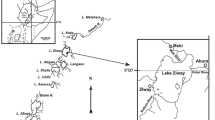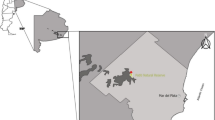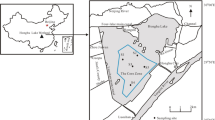Abstract
Purpose
Birds have been used successfully for biomonitoring of the levels and effects of persistent organic pollutants (POPs) in the environments; however, there is exceedingly little data on organochlorinated pesticide (OCPs) and polychlorinated biphenyls (PCBs) residues in bird inhabiting in China. In the present study, we detected the concentrations of PCBs, dichlorodiphenyltrichloroethane and its metabolites (DDTs) and hexachlorocyclohexanes (HCHs) in muscle, liver and kidney of birds that inhabit in an e-waste recycling site. Associated with the stable isotope ratio (δ 15N), we investigated the effect of trophic level on the body burdens of persistent contaminants in birds. The tissue distributions of contaminants in these birds were examined, and a preliminary risk assessment was also conducted.
Materials and methods
Specimens from eight bird species were collected from Qingyuan County, Guangdong Province, South China. Pectoral muscle, liver and kidney tissues were Soxhlet-extracted and finally dissolved in isooctane. Both PCBs and OCPs were analyzed by gas chromatography-mass spectrometry. The subsamples for nitrogen stable isotope analysis were lyophilized, ground and analyzed by a flash EA 112 series elemental analyzer interfaced with an isotope ration mass spectrometer.
Results and discussion
PCBs exhibited the highest concentrations among all target compounds, and a preliminary risk assessment suggested that adverse effects might occur in some birds for its high level. Generally, the concentrations of pollutants in liver and kidney were higher than those in muscle, which was mainly driven by passive diffusion to the ‘lipid-compartment’. Significant differences in level of contaminants were obtained among species due to the varieties in dietary composition and habitat. An increasing trend was obtained between concentrations of PCBs and DDTs with trophic levels; however, HCHs exhibited the same level among species.
Recommendations and perspectives
Because of the e-waste recycling activities, the study area has been heavily polluted by PCBs. Studies on the species-specific hazard assessment associated with exposure to PCBs are urgently needed in the study of birds in the area.


Similar content being viewed by others
References
Anderson DW, Hickey JJ (1972) Eggshell changes in certain North American birds. In: Proceedings of the 15th International Ornithological Congress, The Hague, The Netherlands, pp 514–540
Armitage JM, Gobas FAPC (2007) A terrestrial food-chain bioaccumulation model for POPs. Environ Sci Technol 41:4019–4025
Barron MG, Galbraith H, Beltman D (1995) Comparative reproductive and developmental toxicology of PCB in birds. Comp Biochem Physiol 112C:1–14
Bi X, Thomas GO, Jones KC, Qu WY, Sheng GY, Martin GY, Fu JM (2007) Exposure of electronics dismantling workers to polybrominated diphenyl ethers, polychlorinated biphenyls, and organochlorine pesticides in South China. Environ Sci Technol 41:5647–5653
Borgå K, Gabrielsen GW, Skaare JU (2001) Biomagnification of organochlorines along a Barents Sea food chain. Environ Pollut 113:187–198
Chang H, Deng JX, Zhang GP, Chen WC, Bi XF, Lai DX, Lin S (2003) Birds of Guangdong Nanling national nature reserve. In: Pang XF, Chen JQ (eds) Studies on biodiversity of the Guangdong Nanling National Nature Reserve. Guangdong Science Technology Press, Guangzhou, pp 418–444 (in Chinese)
Chen D, Zhang XL, Mai BX, Sun QH, Song J, Luo XJ, Zeng EY, Robert C (2009) Polychlorinated biphenyls and organochlorine pesticides in various bird species from northern China. Environ Pollut 157:2023–2029
Choi JW, Matsuda M, Kawano M, Min BY, Wakimoto T (2001) Accumulation profiles of persistent organochlorines in waterbirds from an estuary in Korea. Arch Environ Contam Toxicol 41:353–363
Connell DW, Fung CN, Minh TB, Tanabe S, Lam PKS, Wong BSF, Lam MHW, Wong LC, Wu RSS, Richardson B (2003) Risk to breeding success of fish-eating Ardeids due to persistent organic contaminants in Hong Kong: evidence from organochlorine compounds in eggs. Water Res 37:459–467
Elliott KH, Cesh LS, Dooley JA, Letcher RJ, Elliott JE (2009) PCBs and DDE, but not PBDEs, increase with trophic level and marine input in nestling bald eagles. Sci Total Environ 407:3867–3875
Gao F, Luo XJ, Yang ZF, Wang XM, Mai BX (2009) Brominated flame retardants, polychlorinated biphenyls and organochlorine pesticides in bird eggs from the Yellow River Delta, North China. Environ Sci Technol 43:6956–6962
Guruge KS, Tanabe S, Fukuda M (2000) Toxic assessment of PCBs by the 2, 3, 7, 8-tetrachlorodibenzo-p-dioxin equivalent in common cormorant (Phalacrocoraxorax carbo) from Japan. Mar Pollut Bull 34:186–193
Hela DG, Konstantinou IK, Sakellarides TM, Lambropoulou DA, Akriotis T, Albanis TA (2006) Persistent organochlorine contaminants in liver and fat of birds of prey from Greece. Arch Environ Contam Toxicol 50:603–613
Henny CJ, Kaiser JL, Grove RA (2009) PCDDs, PCDFs, PCBs, OC pesticides and mercury in fish and osprey eggs from Willamette River, Oregon (1993, 2001 and 2006) with calculated biomagnification factors. Ecotoxicology 18:151–173
Hu GC, Luo XJ, Dai JY, Zhang XL, Wu H, Zhang CL, Guo W, Xu MQ, Mai BX, Wei FW (2008) Brominated flame retardants, polychlorinated biphenyls, and organochlorine pesticides in giant panda (Ailuropoda melanoleuca) and red panda (Ailurus fulgens) from China. Environ Sci Technol 42:4704–4709
Hua X, Shan Z (1996) The production and application of pesticides and factor analysis of their pollution in environment in China. Adv Environ Sci 4:33–45 (in Chinese)
Jaspers VLB, Covaci A, Voorspoels S, Dauwe T, Eens M, Schepens P (2006) Brominated flame retardants and organochlorine pollutants in aquatic and terrestrial predatory birds of Belgium: levels, patterns, tissue distribution and condition factors. Environ Pollut 139:340–352
Jiménez B, Rodríguez-Estrella R, Merino R, Gómez G, Rivera L, José G, Abad E, Rivera J (2005) Results and evaluation of the first study of organochlorine contaminants (PCDDs, PCDFs, PCBs and DDTs), heavy metals and metalloids in birds from Baja California, México. Environ Pollut 133:139–146
Kay DP, Blankenship AL, Coady KK, Neigh AM, Zwiernik MJ, Millsap SD, Strause K, Park C, Bradley P, Newsted JL, Jones PD, Giesy JP (2005) Differential accumulation of polychlorinated biphenyl congeners in the aquatic food web at the Kalamazoo River superfund site, Michigan. Environ Sci Technol 39:5964–5974
Kelly BC, Ikonomou MG, Blair JD, Morin AE (2007) Gobas FAPC. Food web-specific biomagnifications of persistent organic pollutants. Science 317:236–239
Kenntner N, Krone O, Altenkamp R, Tataruch F (2003) Environmental contaminants in liver and kidney of free-ranging northern goshawks (Accipiter gentilis) from three regions of Germany. Arch Environ Contam Toxicol 45:128–135
Kunisue T, Watanabe M, Subramanian A, Sethuraman A, Titenko AM, Qui V, Prudente M, Tanabe S (2003) Accumulation features of persistent organochlorines in resident and migratory birds from Asia. Environ Pollut 125:157–172
Lam JCW, Murphy MB, Wang Y, Tanabe S, Giesy JP, Lam PKS (2008) Risk assessment of organohalogenated compounds in water bird eggs from South China. Environ Sci Technol 42:296–6302
Leatherbarrow JE, David N, Greenfield BK, Oram JJ, Davies JA (2006) Organochlorine pesticide fate in San Francisco Bay. Oakland, CA.SFEI Contribution #433. pp 54. Available at http://www.sfei.org/rmp/reports/No433_RMP_OCPModel.pdf. Accessed 23 Dec 2009
Li J, Zhang G, Qi SH, Li XD, Peng XZ (2006) Concentrations, enantiomeric compositions, and sources of HCH, DDT and chlordane in soils from the Pearl River Delta, South China. Sci Total Environ 372:215–224
Lilienthal H, Heikkinen P, Danielsson C, Andersson P, Viluksela M (2009) Effects of purity-controlled PCB52 and PCB180 on dopamine-dependent behavior in rat offspring after maternal exposure. Toxicol Lett 189:S229–S230
Lin T, Hu ZH, Zhang G, Li XD, Xu WH, Tang JH, Li J (2009) Levels and mass burden of DDTs in sediments from fishing harbors: the importance of DDT-containing antifouling paint to the coastal environment of China. Environ Sci Technol 43:8033–8038
Luo XJ, Mai BX, Yang QS, Fu JM, Sheng GY, Wang Z (2004) Polycyclic aromatic hydrocarbons (PAHs) and organochlorine pesticides in water columns from the Pearl River and the Macao harbor in the Pearl River Delta in South China. Mar Pollut Bull 48:1102–1115
Luo XJ, Zhang XL, Liu J, Wu JP, Luo Y, Chen SJ, Mai BX, Yang ZY (2009) Persistent halogenated compounds in waterbirds from an e-waste recycling region in South China. Environ Sci Technol 43:306–311
Matthews HB, Dedrick RL (1984) Pharmacokinetics of PCBs. Annu Rev Pharmacol 24:85–103
Minh TB, Kunisue T, Yen NTH, Watanabe M, Tanabe S, Hue ND, Qui V (2002) Persistent organochlorine residues and their bioaccumulation profiles in resident and migratory birds from North Vietnam. Environ Toxicol Chem 21:2108–2118
Naso B, Perrone D, Ferrante MC, Zaccaroni A, Lucisano A (2003) Persistent organochlorine pollutants in liver of birds of different trophic levels from coastal areas of Campania, Italy. Arch Environ Contam Toxicol 45:407–414
Ramesh A, Tanabe S, Kannan K, Subramanian AN, Kumaran PL, Tatsukawa R (1992) Characteristic trend of persistent organochlorine contamination in wildlife from a tropical agricultural watershed, South-India. Arch Environ Contam Toxicol 23:26–36
Ricca MA, Miles AK, Anthony RG (2008) Sources of organochlorine contaminants and mercury in seabirds from the Aleutian archipelago of Alaska: inferences from spatial and trophic variation. Sci Total Environ 406:308–323
Suter GW (2003) Analysis of laboratory and field studies of reproductive toxicity in birds exposed to dioxin-like compounds for use in ecological risk assessment. EPA/600/R-03/114F, National Center for Environmental Assessment Office of Research Development, US Environmental Protection Agency
Tanabe S, Senthilkumar K, Kannan K, Subramanian AN (1998) Accumulation features of polychlorinated biphenyls and organochlorine pesticides in resident and migratory birds from South India. Arch Environ Contam Toxicol 34:387–397
UNEP (2001) Final act of the conference of plenipotentiaries on the Stockholm convention on persistent organic pollutants, Stockholm, Sweden
Van den Berg M, Birnbaum L, Bosveld AT, Brunstrom B, Cook P, Feeley M, Giesy JP, Hanberg A, Hasegawa R, Kennedy SW, Kubiak T, Larsen JC, van Leeuwen FX, Liem FX, Nolt C, Peterson RE, Poellinger L, Safe S, Schrenk D, Tillitt D, Tysklind M, Younes M, Waern F, Zacharewski T (1998) Toxic equivalency factors (TEFs) for PCBs, PCDDs, PCDFs for humans and wildlife. Environ Health Perspect 106:775–792
Van den Steen E, Jaspers VLB, Covaci A, Dauwe T, Pinxten R, Neels H, Eens M (2008) Variation, levels and profiles of organochlorines and brominated flame retardants in great tit (Parus major) eggs from different types of sampling locations in Flanders (Belgium). Environ Int 34:155–161
Van den Steen E, Jaspers VLB, Covaci A, Neels H, Eens M, Pinxten R (2009) Maternal transfer of organochlorines and brominated flame retardants in blue tits (Cyanistes caeruleus). Environ Int 35:69–75
Van Drooge B, Mateo R, Vives I, Cardiel I, Guitart R (2008) Organochlorine residue levels in livers of birds of prey from Spain: inter-species comparison in relation with diet and migratory patterns. Environ Pollut 153:84–91
Viluksela M, Heikkinen P, van der Ven L, Miettinen HM, Korkalainen M, Savolainen K, Lilienthal H, Adamsson A, Toppari FM, Tuukkanen J, Hamscher G, Andersson PL, Schrenk D, Halldin K, Helen H (2009) Toxicological profile of high purity PCB 180 in adult rats. Toxicol Lett 189:S103
Voorspoels S, Covaci A, Lepom P, Jaspers VLB, Schepens P (2006) Levels and distribution of polybrominated diphenyl ethers in various tissues of birds of prey. Environ Pollut 144:218–227
Wang YW, Wang TH, Li A, Fu JJ, Wang P, Zhang QH, Jiang GB (2008) Selection of bioindicators of polybrominated diphenyl ethers, polychlorinated biphenyls, and organochlorine pesticides in mollusks in the Chinese Bohai Sea. Environ Sci Technol 42:7159–7165
Westerholm E, Boix J, Miettinen HM, Roos R, Antunes-Fernandes E, Westerink R, van Duursen M, Stenberg M, Carreira SC, Machala M, Silins I, Stenius U, Halldin K, Hanberg A, Håkansson H (2009) ATHON NDL-PCB effect database-A tool to facilitate the cumulative risk assessment of NDL-PCBs. Toxicol Lett 189:S244–S244
Xing Y, Lu YL, Dawson RW, Shi YJ, Zhang H, Wang TY, Liu WB, Ren HC (2005) A spatial temporal assessment of pollution from PCBs in China. Chemosphere 60:731–739
Zhang G, Parker A, House A, Mai BX, Li XD, Kang YH, Wang ZS (2002) Sedimentary records of DDT and HCH in the Pearl River Delta, South China. Environ Sci Technol 36:3671–3677
Zhang Y, Luo XJ, Wu JP, Liu J, Wang J, Chen SJ, Mai BX (2010) Contaminant pattern and bioaccumulation of legacy and emerging organhalogen pollutants in the aquatic biota from an e-waste recycling region. Environ Toxicol Chem 29:852–859
Acknowledgements
This work was financially supported by several projects (NSFC20890112, SKLOG2009A04, NSFC40873074) and the National Basic Research Program of China (No. 2009CB421604).
Author information
Authors and Affiliations
Corresponding author
Additional information
Responsible editor: Henner Hollert
Rights and permissions
About this article
Cite this article
Zhang, XL., Luo, XJ., Liu, J. et al. Polychlorinated biphenyls and organochlorinated pesticides in birds from a contaminated region in South China: association with trophic level, tissue distribution and risk assessment. Environ Sci Pollut Res 18, 556–565 (2011). https://doi.org/10.1007/s11356-010-0397-9
Received:
Accepted:
Published:
Issue Date:
DOI: https://doi.org/10.1007/s11356-010-0397-9




